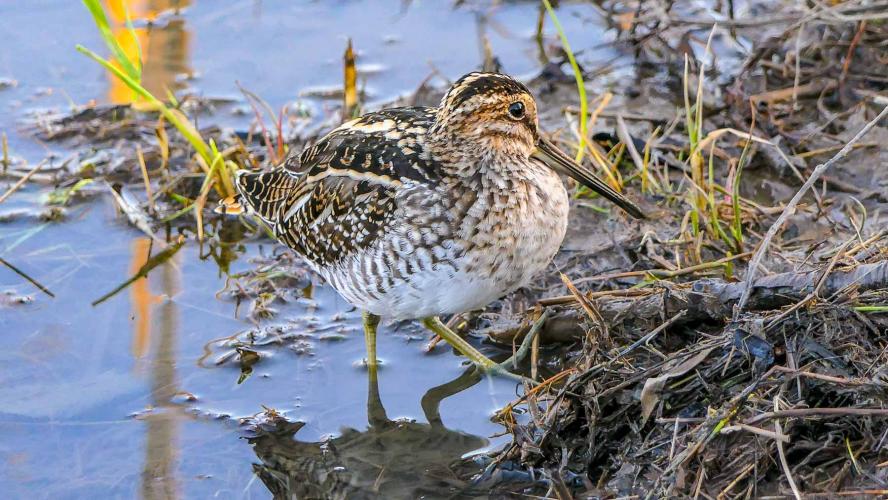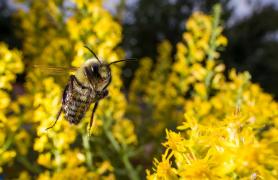When you’re at the lake or along a river this summer, keep your eyes peeled for leggy, beaky birds poking at the shoreline, especially in August. That’s when Missouri’s fall shorebird migration gets into full swing. Every year, some shorebirds like the pectoral sandpiper fly thousands of miles to reach their southern wintering grounds. While they’re in Missouri, they’ll be wading in shallow water, skittering along mudflats, or probing wet fields for snails, bugs, and other tasty treats to feed their need for speed. The pectoral sandpiper, for example, can reach cruising speeds of 50 mph during migration.
The shorebird that migrates the farthest, however, is the American golden plover. It nests in the Arctic tundra in northern Canada and Alaska. In fall, it flies over the Atlantic Ocean down to southern South America for the winter. Round-trip, it travels more than 20,000 miles nearly every year! The shorebird with the shortest commute to Missouri is probably the American woodcock. Its winter range reaches from southern Missouri down to the Gulf Coast. In the summer, it ranges farther up into Missouri and as far north as central Canada.
Find a Wetland Near You
Shorebirds love wetlands! These are marshy places where they can feed, rest, and take cover from predators. Find your nearest Missouri wetland at short.mdc.mo.gov/Z7X.
Shorebirding Basics
Not all shorebirds seek food and friends at the beach. The killdeer, for example, is just as likely to feed in a wet field as a wetland. And the American woodcock hides in wet woods all day. Wherever you spot shorebirds, it helps to carry a good pair of binoculars and focus on these features:
- Beaks. Shorebird beaks tend to be long and pointed, the better to probe the silt or soil or swish the water for squishy, crunchy munchables.
- Legs. Except for the woodcock, most shorebirds’ legs are on the long side. This helps with wading and chasing bugs.
- Feet. Not webbed, but with toes that are long and wide-set. This helps shorebirds stand in soft, wet mud but not sink into it.
- Feeding behavior. Regardless of their favorite kinds of “beaches,” all shorebirds probe or dab for critters with their beaks.
Black-Necked Stilt
With long, pink legs and black-and-white plumage, this boldly marked shorebird is easy to recognize. Look for it wading in shallow water. Black-necked stilts are noisy, especially when disturbed, so listen for high pitched yapping, which carries a long way.
Where to spot it:
For a late-summer shorebirding adventure, camp at Lake Wappapello State Park and visit nearby Duck Creek Conservation Area or Mingo National Wildlife Refuge early in the morning.
Pectoral Sandpiper – Spring and Fall visitor
Look for this medium-sized shorebird feeding in grassy wetlands and wet pastures. If you flush one (that means scare it into flight, not what you were probably thinking), it may give a sharp, twittering churt. Like the American golden-plover, it nests on the Arctic tundra and winters in South America.
Where to spot it:
Try any Missouri wetland like Eagle Bluffs Conservation Area in Boone County.
American Woodcock
This chunky, odd-looking shorebird is a cousin of the pectoral sandpiper. But instead of grassy wetlands, it prefers the deep cover of wet thickets, moist woods, and brushy swamps. There, it spends its days probing the wet soil for earthworms. It’s active only at dawn and dusk, so you might never see it unless you’re outside near wet woods in the evening.
Where to spot it:
Try the hiking trails at Weldon Spring Hollow Natural Area within Weldon Spring Conservation Area in St. Charles County.
Wilson’s Snipe - Spring and Fall Visitor
Like the woodcock, this member of the sandpiper family avoids mudflats. Instead, it prefers moist grassy areas, swamps, shallow marshes, or even drainage ditches. You seldom see these shy birds until you are nearly upon them, when they abruptly rocket into the sky and fly away in a zigzag pattern.
Where to spot it:
Visit an easy-to access wetland like Pershing State Park between Laclede and Meadville.
American Golden-Plover - Spring and Fall Visitor
Compared to most shorebirds, this little plover’s beak is kind of short and stout. It eats seeds and berries as well as tiny water critters. In Missouri, look for it on prairies, farms, mudflats, and shorelines.
Where to spot it:
While most American golden-plovers take the Atlantic route south during fall migration, some come through Missouri. You might see them at B.K. Leach Conservation Area in Lincoln
Killdeer
You’ve probably heard this loudmouthed member of the plover family announce its return to Missouri in April. Kill deer! Kill deer! In August, look for its run-pause-peck feeding behavior on pastures, mudflats, and lake shores.
Where to spot it:
Truman Reservoir Visitor Center in Benton County is a great place to see killdeer and many other kinds of shorebirds.
Lesser Yellowlegs - Spring and Fall visitor
This one’s easy. It has long, yellow legs, a straight beak, and it’s about 11 inches tall. Its cousin, the greater yellowlegs, is larger and has a slightly upturned beak. Look for lesser yellowlegs wading wetlands and flooded fields in belly-deep water. Rather than probing, the yellowlegs dabs at the water and swings its beak at small fish.
Where to spot it:
You’re likely to see this shorebird at any Missouri wetland area in any part of the state.
















Also In This Issue

This Issue's Staff
Les Fortenberry
Angie Daly Morfeld
Noppadol Paothong
Marci Porter
Mark Raithel
Laura Scheuler
Matt Seek
David Stonner
Stephanie Thurber
Cliff White






















